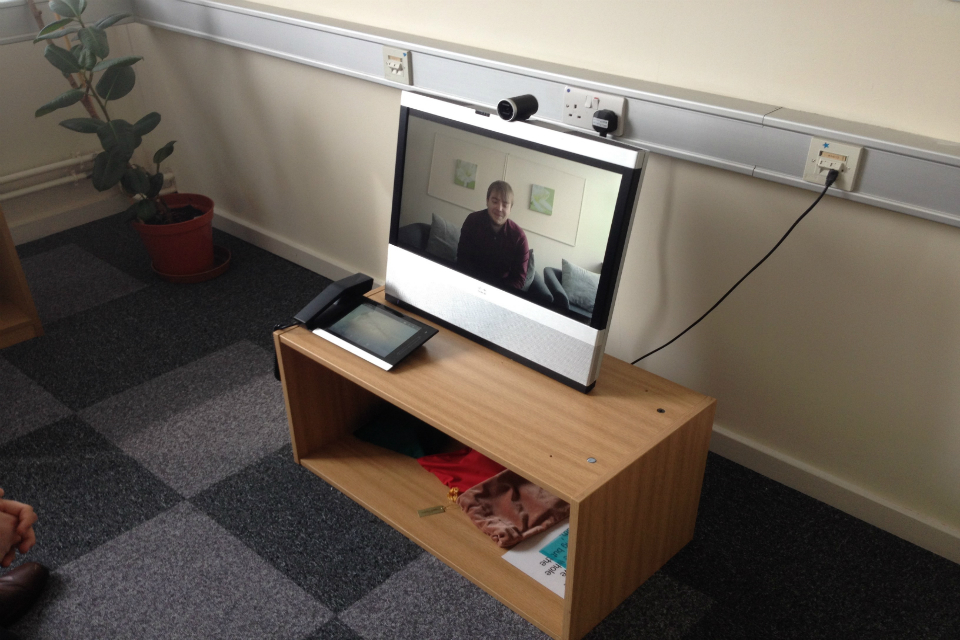[English] - [Cymraeg]
In my last blog post, I talked about the opportunities (and responsibility) presented by the ‘once in a generation’ £1 billion investment in our courts and tribunals. This work will re-shape how we enable access to the justice system and how we deliver our reformed public services in the future. In this blog post I will discuss the implementation of remote working, specifically virtual hearings.
To make sure we reduce inconvenience and cost to our users and provide greater flexibility and access to our services, we must deal with cases in the most efficient and proportionate way. One of the ways in which we are doing this is the expansion of video and telephony links to provide remote access either into a physical court room or into the new design of a ‘virtual court room’.
The use of video links already allows victims and vulnerable people to take part in criminal proceedings without having to meet the defendant face-to-face. Telephone conference technology is also already used (to a limited degree) to progress and manage cases in most jurisdictions and for a range of cases. To achieve effective fully virtual hearings, where all parties including the judge, are remote from the court room, we must look at the interactions that currently take place immediately before and after the hearing to make sure we replicate this important activity and, where possible, enhance it. By designing this new service around those who will use it, including those who are seeking justice as well as our justice partners, the judiciary and our staff, we give ourselves the best chance of identifying the right technology required and the right capability and processes to run it.

How we are going to do it
We want to offer a range of hearing options to all jurisdictions including the fully virtual option, to hearings that still have one or more parties within a physical courtroom but with access to new systems and technology to use video or telephony more effectively. Not only will this increase flexibility for our users by reducing the need for time-pressed citizens, legal and other justice professionals to travel back and forth to and wait around in our court buildings. It will also reduce the time and risk associated with transporting prisoners.
We will not mandate virtual hearings - these will only take place where the court or tribunal considers that it is in the interests of justice.
We are working closely with the jurisdictional service projects to work out which users, which hearings and which case types will be suitable for remote working.
What are the next steps
We are working with partners from Microsoft to build a prototype for a fully virtual hearing, which we will be testing in October 2017 for case management hearings in the Immigration and Asylum Chamber with judges, HMCTS staff, the legal profession and Home Office Presenting Officers.
We’ll use this blog to keep you updated on progress for virtual hearings. Please use the comments section at the bottom of the page to leave me your views. You can also ensure you keep informed of our progress by subscribing to our email alerts service.
[English] - [Cymraeg]
Sut fydd gweithio o bell yn rhoi mwy o hyblygrwydd i ddefnyddwyr a’r llysoedd
Yn fy mlog diwethaf, mi soniais am y cyfleoedd (a'r cyfrifoldeb) sy'n deillio o'r buddsoddiad o £1 biliwn 'unwaith mewn cenhedlaeth' yn ein llysoedd a'n tribiwnlysoedd. Bydd y gwaith hwn yn ailffurfio sut bydd unigolion yn cael mynediad i’r system cyfiawnder a sut byddwn yn darparu ein gwasanaethau cyhoeddus diwygiedig yn y dyfodol. Yn y blog hwn, byddaf yn trafod y broses o gyflwyno gweithio o bell, ac yn benodol gwrandawiadau rhith.
Er mwyn sicrhau ein bod ni’n lleihau anghyfleustra a chost i’n defnyddwyr ac yn gwella hyblygrwydd a mynediad i’n gwasanaethau, mae’n rhaid i ni ddelio ag achosion yn y ffordd fwyaf effeithlon a chymesur. Un o’r ffyrdd yr ydym yn gwneud hyn yw drwy ehangu’r defnydd a wneir o gysylltiadau fideo a ffôn er mwyn darparu mynediad o bell i naill ai ystafell llys draddodiadol neu i’r dyluniad newydd o ‘ystafell llys rith’.
Mae cysylltiadau fideo eisoes yn galluogi dioddefwyr ac unigolion bregus i gymryd rhan mewn achosion troseddol heb orfod gweld y diffynnydd wyneb yn wyneb. Fe ddefnyddir technoleg cynadledda dros y ffôn yn barod (i lefel gyfyngedig) er mwyn symud achosion yn eu blaen a’u rheoli yn y rhan fwyaf o awdurdodaethau ac ar gyfer amrywiaeth o achosion. Er mwyn cael gwrandawiadau cwbl rith effeithlon, lle bydd yr holl bartïon gan gynnwys y barnwr, yn rhywle heblaw’r ystafell llys, bydd rhaid i ni edrych ar y rhyngweithiadau sy’n digwydd ar hyn o bryd cyn ac ar ôl y gwrandawiad er mwyn sicrhau ein bod yn dyblygu’r gweithgaredd pwysig hwn a, lle bo modd, ei wella. Drwy ddylunio’r gwasanaeth newydd hwn o amgylch y rhai hynny fydd yn ei ddefnyddio, gan gynnwys y rhai hynny sy’n ceisio cyfiawnder yn ogystal â’n partneriaid cyfiawnder, y farnwriaeth a’n staff, rydym yn rhoi’r siawns orau i ni ein hunain adnabod y dechnoleg briodol sydd ei hangen a’r galluoedd a’r prosesau cywir i’w rhedeg.
Sut byddwn yn gwneud hyn
Rydym eisiau gallu cynnig amrywiaeth o opsiynau ar gyfer gwrandawiadau i’r holl awdurdodaethau gan gynnwys yr opsiwn cwbl rith i wrandawiadau sydd dal ag un neu fwy o bartïon mewn ystafell llys draddodiadol ond gyda mynediad i systemau newydd a thechnoleg i ddefnyddio cysylltiadau fideo neu ffôn yn fwy effeithlon. Bydd hyn nid yn unig yn gwella hyblygrwydd ar gyfer ein defnyddwyr drwy leihau’r angen i ddinasyddion sydd heb lawer o amser, gweithwyr cyfreithiol a gweithwyr cyfiawnder proffesiynol eraill deithio yn ôl ac ymlaen ac aros o gwmpas yn ein hadeiladau llysoedd, ond bydd hefyd yn lleihau’r amser a’r risg sy’n gysylltiedig â chludo carcharorion.
Ni fyddwn yn mandadu gwrandawiadau rhith – dim ond pan fydd y llys neu dribiwnlys yn ystyried ei fod er budd cyfiawnder y bydd hyn yn digwydd.
Rydym yn gweithio’n agos â’r prosiectau gwasanaeth awdurdodaethol er mwyn canfod pa ddefnyddwyr, gwrandawiadau a'r mathau o wrandawiadau fydd yn addas ar gyfer gweithio o bell.
Beth yw’r camau nesaf
Rydym yn gweithio â phartneriaid o Microsoft er mwyn cynhyrchu prototeip ar gyfer gwrandawiad cwbl rith, fydd yn cael ei brofi ym mis Hydref 2017 ar gyfer gwrandawiadau rheoli achos yn y Siambr Mewnfudo a Lloches gyda barnwyr, staff GLlTEM, y proffesiwn cyfreithiod a Swyddogion Cyflwyno'r Swyddfa Gartref.
Byddwn yn defnyddio’r blog hwn i’ch diweddaru ar unrhyw gynnydd o ran gwrandawiadau rhith. Defnyddiwch yr adran sylwadau sydd ar waelod y dudalen i leisio eich barn. Gallwch hefyd sicrhau eich bod yn cael gwybod am unrhyw ddatblygiadau drwy danysgrifio i’n gwasanaeth negeseuon e-bost.

3 comments
Comment by Lourens van Zyl (Cape Town, RSA) posted on
Dear Madam,
Thank you for your efforts herein.
May I express the hope, with the realization which immediately rises in my mind that it is my responsibility to realize this hope, that your project would be adapted for Africa, where it can eliminate numerous practical difficulties :- travel, expense, waiting time and quick dealing with of minor cases.
Comment by Graham posted on
Hi Fiona,
Thanks for your blog, It's very encouraging to see how the MOJ is embracing technology to enhance the Justice system.
Last year I worked on a similar project with Kent Police which I believe was very successful, utilizing web conferencing to operate a fully virtual court.
I'm sure you're aware of the project, if not please email me to discuss.
Regards,
Graham.
Comment by Rhiannon Evans posted on
Good blog. Great ambition that has massive benefits for so many different people. I look forward to seeing the developments.
One thought - It's Important to ensure that the value of in person support for victim and witness is not underestimated or lost. I'm sure that the same could be said for defendants but for Victims and witnesses giving evidence remotely has huge value for them but the Witness Service still needs to be able to provide support so needs to be incorporated into the model.